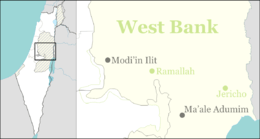Rimonim
Rimonim (Hebrew: רִמּוֹנִים, רימונים), is an Israeli settlement in the West Bank. Located on the Allon Road, about a twenty-minute drive east from Jerusalem, it falls under the jurisdiction of Mateh Binyamin Regional Council. In 2018 it had a population of 687.[1]
Rimonim רִמּוֹנִים | |
|---|---|
 Rimonim | |
| Coordinates: 31°56′03″N 35°20′24″E | |
| Country | Israel |
| District | Judea and Samaria Area |
| Council | Mateh Binyamin |
| Region | West Bank |
| Affiliation | Agricultural Union |
| Founded | 1977 |
| Founded by | Nahal |
| Population (2018)[1] | 687 |
The international community considers Israeli settlements in the West Bank illegal under international law, but the Israeli government disputes this.[2]
Etymology
The village is named after the biblical Rock of Rimmon (present-day Rammun). The name comes from the Book of Judges:
But six hundred men turned and fled toward the wilderness unto the rock of Rimmon, and abode in the rock of Rimmon four months.
History
According to ARIJ, Israel confiscated 393 dunam of land from the nearby Palestinian town of Taybeh in order to construct Rimonim in 1977.[3]
Rimonim was first established in 1977 (20 Shevat 5737) as a temporary pioneer Nahal military outpost. Three years later in 1980 (on 4 Tishrei 5741), it moved to the current location, demilitarized and turned over to residential purposes non-religious Jewish Israelis with help from the Amana settlement organization. In the mid-2000s the village allowed religious Jews to move in. Until then, it had been almost exclusively secular in nature.
Services provided include a synagogue, half-Olympic sized swimming pool, post office, nursery, kindergarten, mikveh, library, basketball court, and youth centre.
At the edge of town, there is a look-out point, from which one can view the Jordan Valley and the Dead Sea.
References
- "Population in the Localities 2018" (XLS). Israel Central Bureau of Statistics. 25 August 2019. Retrieved 26 August 2019.
- "The Geneva Convention". BBC News. 10 December 2009. Retrieved 27 November 2010.
- Et Taiyiba Town Profile (including Badiw al Mu’arrajat Locality), ARIJ, p. 21
External links
- Official website
- Rimonim Mateh Binyamin Regional Council